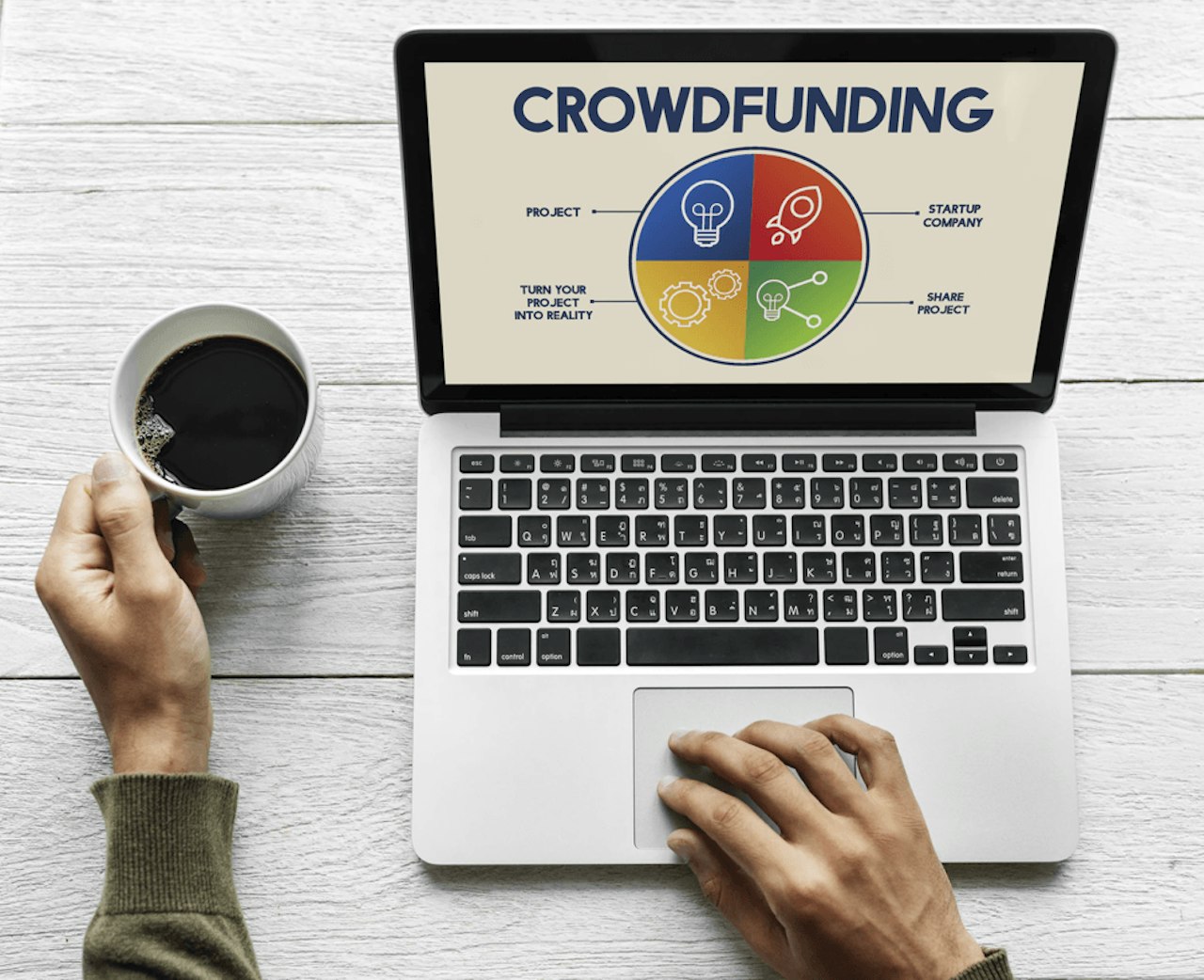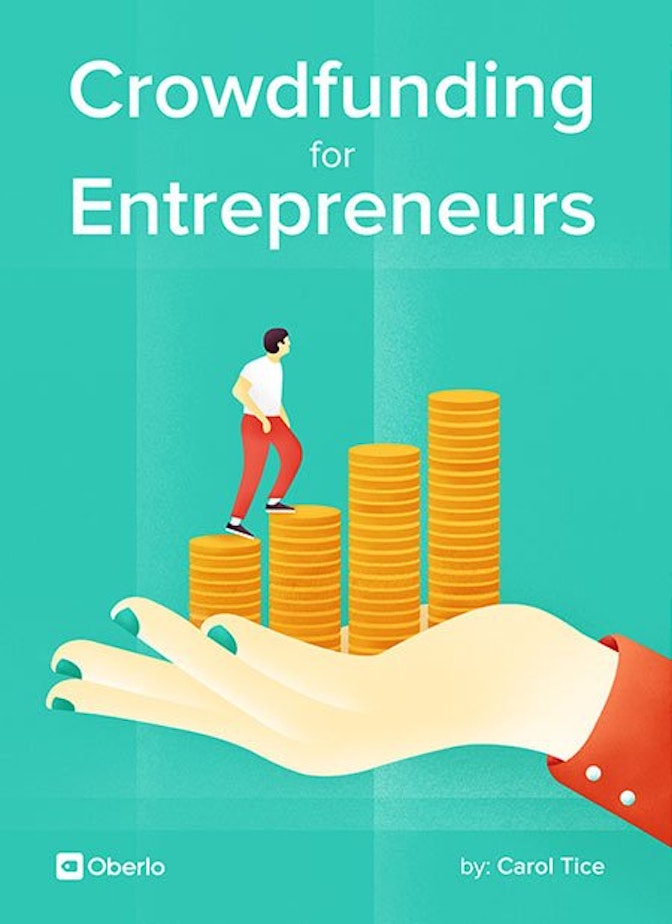Congratulations—you’ve started a business. Go, you! Probably, soon after you opened your doors or hung out your virtual shingle, a singular thought came to you: This business needs money.
Crowdfunding is an increasingly popular way to get those funds—and this e-book is your shortcut to success.
What are your other fundraising options? Maybe you’ve got a rich uncle. Or you’ve got a stellar credit rating, and are willing to risk your home to take out a personal loan to fuel your startup.
If you don’t have either of those options, there’s crowdfunding.
What is crowdfunding, exactly? This e-book will walk you through everything you need to know about raising money online: You’ll get a solid crowdfunding definition, learn how it works, and find out how to make your campaign a success.
There’s a lot to know if you want to win at crowdfunding (including several different basic methods). So I’ve rounded up tips from top experts, included my own insights from covering the sector for over a decade, and offered loads of examples to inspire and guide your journey.
We won’t only address the phenomenon of crowdfunding; we’ll look at what crowdfunding is for entrepreneurs specifically. That’s why this isn’t just any old e-book about crowdfunding—it’s your insider’s guide.



Who I Am

Carol Tice, Make A Living Writing
How did I come to write a book about crowdfunding? I’m a longtime business reporter who began reporting on crowdfunding way back when crowdlending platform Prosper.com first hit the United States in 2006. I’ve since also been a crowdlending investor.
Over the years, I’ve spoken with many entrepreneurs in various industries about their campaigns, both successful and not. More recently, I’ve reported on crowdfunding for Forbes.com, most notably this piece. I hate seeing entrepreneurs waste time and energy, so I’ve written this e-book to help you avoid common crowdfunding mistakes.
→ Click Here to Launch Your Online Business with Shopify
Ready to get started raising money for your startup? To begin, let’s answer the primary question: ‘What is crowdfunding?’
A Crowdfunding Definition
There are a lot of crowdfunding definitions bouncing around online—so if you’re a little confused about it, don’t feel alone. Let’s iron this out right now!
What is crowdfunding? Below is the definition we’ll use in this e-book (inspired in part by this definition on Investopedia):
Crowdfunding is the raising of small amounts of money from a large number of individuals.
Some crowdfunding definitions state that crowdfunding is a vehicle only for startups, but that’s not true. Crowdfunding can be used to raise funds for established businesses, charities, and individuals, too. Others refer to crowdfunding as using money from many investors, but that part happens after you crowdfund.
For the purposes of this e-book, think of crowdfunding simply as the activity of raising funds from many people.
How Popular Is Crowdfunding?
Since crowdfunding began in the early 2000s, it’s seen skyrocketing growth. In little more than a decade, crowdfunding transactions in the U.S. shot from zero to a projected $1 billion in 2018, statistics portal Statista forecasts. Statista projects that U.S. crowdfunding will grow 50% to just over $1.5 billion in 2022.
The global crowdfunding projection is even bigger:
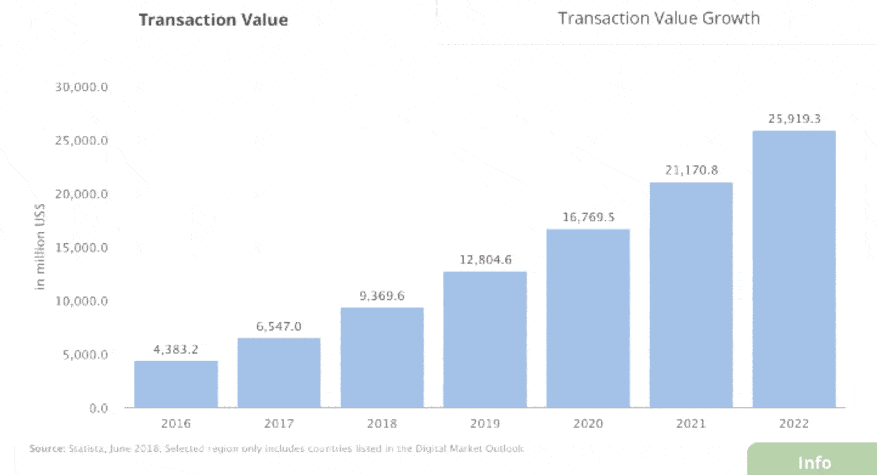
To sum up: Crowdfunding is big business!
Worldwide, crowdfunding is a $7.5 billion industry, including all funds raised online by individuals, nonprofits, and businesses. In the U.S., over 188,000 parties will receive crowdfunded dollars in 2018, with an average of $5,500 raised per campaign, Statista says.
Ready to get your startup some money? Let’s take a look at how crowdfunding is done.
How Does Crowdfunding Work?
What is crowdfunding? At its essence, it involves your startup’s soliciting many backers online. Okay, but you may be asking—what is the process of crowdfunding, exactly?
Think of the road to your successful campaign as something you build step-by-step. Here’s a quick road map:
Pick a Project or Product
Most crowdfunding platforms—particularly rewards-based platforms—require that you raise money for a specific, definable activity. Vague proclamations of growth or cash-flow needs won’t cut it. To begin, you’ll need to know what the money raised will fund.
Set a Budget and Goal
What funds do you have available for creating and marketing this crowdfunding campaign? What will it cost to deliver your rewards? Figure it out now.
How much can you realistically raise? It’s key that you choose a goal you think you can achieve. Some startups set a very low goal their first time out, to be sure they make it.
Choose a Time Frame and Method
The best crowdfunding campaigns have a set time limit for fundraising. You’ll need to decide your time frame and deadline.
Choose whether you’re pursuing rewards, equity, or loan-based crowdfunding (more on these below). If you’re choosing equity, start preparing the required legal paperwork.
Pick a Crowdfunding Platform
Every platform has its own rules, so pick the one that best suits your startup’s situation (see the following chapter for comparisons of the top players’ models).
On some crowdfunding platforms, if you don’t hit your goal by the deadline, your startup will get zero, a system known as ‘all or nothing.’
Other platforms allow you to keep whatever you raise. Still others allow you to fundraise perpetually, or to continue raising more if you meet your goal by the deadline.
Pre-Publicize
If there’s one thing crowdfunding experts agree on, it’s that you need to build an audience well in advance of your campaign launch (unless you’re doing equity crowdfunding—more on that later).
Create a Marketing Plan
Know in advance exactly how you’ll promote your crowdfunding campaign.
Will you do daily video updates live on Facebook? Do you have a ‘street team’ of raving fans who’ll be talking about your campaign on social media?
Figure out all the ways you could promote your campaign—and most importantly, who will be in charge of executing each marketing activity.
Create Your Crowdfunding Campaign
Once you think you’ve got a following large enough to support your fundraising goals, it’s time to create your campaign page. Choose your rewards if using rewards-based crowdfunding, prepare your paperwork for equity fundraising, and get ready to tell your story.
Launch
From launch day on, you’ll need to promote, promote, promote the heck out of your campaign. Be actively involved in generating excitement around your launch. The first few days are key, as strong initial backing tends to attract more investors to your page.
Communicate
While your campaign is running, communicate often with backers. Promptly answer any questions prospective backers have.
Fulfill
Once your campaign ends, if you’re doing a rewards-based fundraise, you’ll need to quickly get your rewards out to your backers. If there are any delays, communicate right away and let funders know what to expect. Keep equity investors updated and engaged.
Reflect
After your campaign is over, it’s good to take time to review what went right and wrong. Document what happened, so that if you go out to raise money again, you benefit from lessons learned the first time.
What Is Crowdfunding For Business?
Why are so many entrepreneurs excited about crowdfunding? What is crowdfunding’s appeal? Well, prior to the past decade or so, it was nearly impossible to quickly raise business funding from many investors at once.
If you needed capital for your startup, your options were limited before crowdfunding came along. Entrepreneurs tapped that wealthy uncle, got a bank loan, self-funded, or raised funds from wealthy individual ‘angel’ investors or venture capital (VC) firms.
That is, if you could attract angels or VC firms. Mostly, many startups simply didn’t get funded. As a result, many startups grew very slowly, or flat-out went bust.
By contrast, crowdfunding offers entrepreneurs an easier route to startup fundraising.
The difference in a nutshell: If a company needs to raise $30,000, the founders might find three angels to invest $10,000 apiece. Or, in a crowdfunding campaign, 300 investors might contribute $100 apiece (or 3,000 investors commit $10 apiece). Magical! It’s usually easier to get many people to pony up a small amount than it is to get a few people to put up a bundle each.
[highlight]In theory, you could do crowdfunding without the internet, by knocking on many doors or making hundreds of phone calls or emails to assemble your ‘crowd.’ But in reality, that’s just too hard to accomplish.[/highlight]
The internet makes it possible to more easily connect to hundreds (or thousands) of people who could each contribute a small amount of funding. The web also helps entrepreneurs track and fulfill on rewards promised to their backers. Online fundraising has enabled many more startups to find the capital they need to grow.
Now that we’ve answered the basic ‘What is crowdfunding?’ question, let’s look at why businesses are increasingly making use of this form of fundraising.
The Benefits of Crowdfunding For Your Business
Now that you have a basic understanding of what crowdfunding is, let’s talk about the many ways a campaign could benefit you. (Hint: Crowdfunding can bring your startup much more than just a cash injection.)
Here are the top fringe benefits to raising business capital online:
Conduct Market Research
Running a campaign is a great way to get quick, real-world feedback on your product or service. Would customers prefer your widget in a different size or color, or with different features? You can offer a range of choices in your campaign and see what’s most popular. The comments you get in a campaign can help you quickly adjust your offering to make more sales.
Build Your Audience
A popular campaign will attract new customers through the platform you choose—people who’ve never heard of your brand before. You can emerge from a crowdfunding round with a bigger customer or prospect list to mine in future.
Raise Your Profile
A successful campaign can draw lots of free publicity, as newspapers, magazines, and blogs spotlight what you’ve done. Appearing in the media conveys legitimacy and may open the door to future opportunities.
Impress Angel Investors
Angel investors and VC firms love to see a successful history of previous fundraising. Your effort may attract investors who offer traditional funding later on, as well as expertise to help your business grow.
Get Brand Ambassadors
People who invest in campaigns tend to get super-excited about what you offer. As you build fans, they’ll light up social media, becoming a source of free publicity and positive buzz.
Now that you understand the many benefits to crowdfunding, let’s talk about exactly how to do it. There are three different types of crowdfunding that startups can take advantage of—and the next section details how each one works.
Three Types of Crowdfunding For Business
There are three basic types or flavors of online fundraising for business (plus one other type that doesn’t work well for startups): rewards-based crowdfunding, peer-to-peer lending or crowdlending, and equity crowdfunding. The chart below shows the popularity of each of the three main types.
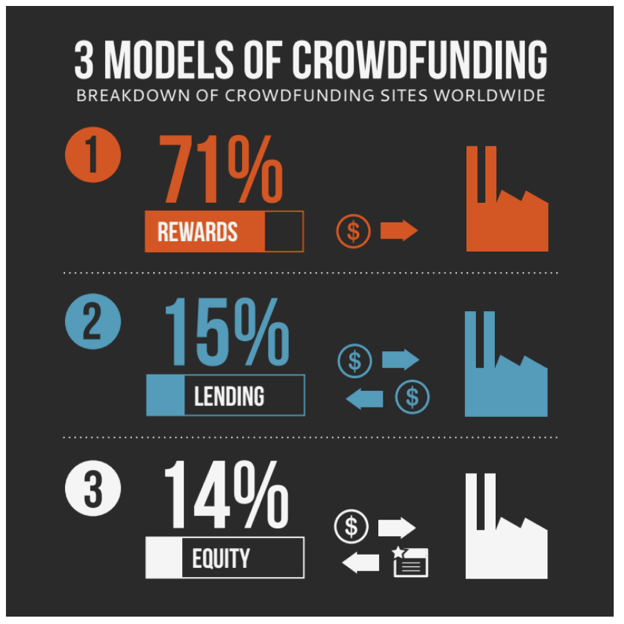
Let’s run these crowdfunding types down, one at a time:
1. Rewards-Based Crowdfunding
As you can see from the chart above, this is the most popular type. It’s also the one most people know about, thanks to the high visibility of top platforms Kickstarter and Indiegogo.
In rewards-based crowdfunding, your startup seeks to raise money for a new product or project. To incentivize funders to participate in your campaign, your business offers them rewards. Rewards-based crowdfunding can be a great way to start a successful e-commerce store. You can crowdfund for products of every type, from tech gadgets to T-shirts.
For instance, if you’re creating a new wristwatch, your campaign might offer funders the chance to get that new watch first, before it’s publicly sold. Backers often get a discount off planned retail prices, or a chance to get limited-edition colors or added features. They might also get insider access, such as a factory tour or a call with the founder.
Pros: The prime advantage of rewards-based crowdfunding is that you don’t give up any ownership or equity in your company. Instead, you essentially take pre-orders for your next product or program. This early money can pay a factory that requires an up-front deposit to manufacture your goods. Also, the funding you receive in a rewards-based campaign isn’t debt, so you have no loan payments to make.
Cons: In rewards-based crowdfunding, you have to deliver the rewards you’ve promised. The pressure to quickly create and deliver your promised rewards can be intense. Failure to deliver rewards can damage your company’s reputation, and your startup can end up getting sued.
2. Equity-Based Crowdfunding
A small portion of startups elect to tap the online investor crowd to raise money. This is the world of equity-based crowdfunding, which is also known as crowdinvesting. Raising equity online from a large pool of investors has requirements that many startups won’t be able to meet. Big picture: There’s a lot more paperwork and cost to doing crowdinvesting than there is in rewards-based fundraising.
But plenty of startups find it well worth the effort.
[highlight]You cannot use equity crowdfunding if you’re a convicted felon. Move on to check out the other types of crowdfunding.[/highlight]
In America, there are several different defined methods for equity crowdfunding, which I describe below. (Outside the U.S.? You’ll need to research regulations in your country.)
Raising money with equity crowdfunding usually means you’ll be giving up some ownership of your startup. There’s a decent amount of jargon used in equity crowdfunding, so I’m going to break it down for you. Here are the equity-based options:
Forms of equity crowdfunding
Most equity crowdfunding investments online take one of a few basic forms, in terms of what investors get for their money:
Common or preferred stock—Your investors accept privately issued shares of stock in your company in exchange for their investment. The shares grow in value if your company’s value grows over time and shrink if it declines.
Convertible debt—Investor-backed debt isn’t like getting a crowdfunded loan. You don’t owe monthly loan payments.
Instead, this debt converts into an equity ownership stake in your company at a future point. The conversion happens if your startup has a ‘trigger event,’ such as the completion of a new fundraising round, company sale, or initial public stock offering (IPO). These are complex deals—you will owe interest when this debt converts to equity, and will need to negotiate a valuation ‘cap’ that limits how much equity investors can gain.
A SAFE—An alternative to convertible debt, a SAFE (Simple Agreement for Future Equity) gives investors the right to purchase company stock when the next round of fundraising happens. As with convertible debt, you’ll set a valuation cap.
Revenue share—In a revenue-share equity deal, you pay back your investors out of your monthly revenue until the investment is paid off, plus a profit of usually about 50%, says Bill Clark, founder/CEO of the equity crowdfunding platform Microventures. The win here? You retain full ownership of your startup.
[highlight] Now that you know the basic forms an equity deal can take, you need to decide what type of equity fundraising you want to do. There are three different rules under which you can do equity crowdfunding in the U.S. The right one for you will depend on your startup’s track record and how much you want to raise. [/highlight]
Here’s a quick look at the three options:
Equity crowdfunding: Three regulations to know
- Regulation CF or Regulation Crowdfunding allows startups to raise up to $1 million ($1,070,000, to be precise) from non-accredited investors. Most equity fundraising online is Regulation CF.
- Regulation A+ allows businesses to sell shares of company stock to non-accredited investors through an online IPO, raising up to $50 million.
- 3. Regulation D allows startups to raise unlimited funds, but only from accredited investors. This is basically the old-fashioned way to raise equity, brought online. Only a few online platforms offer Regulation D equity crowdfunding.
Pros: Equity crowdfunding online allows you to connect with investors outside your own network. You can also often raise larger sums than companies typically get in rewards-based crowdfunding. Some of these online investors may also prove to be good connections, brand ambassadors, or mentors for your business.
Cons: Get ready to climb a costly paperwork mountain to qualify for equity crowdfunding (bare bones, you’re spending several thousand dollars). You’ll need to hire an accountant (or two) and a lawyer to help you file required federal or country-specific legal paperwork.
There’s a lot of regulatory-compliance hoops to jump through. You’ll also need to find an equity platform to accept your campaign—and many accept only a small percentage of companies that apply. This all takes time, and it may delay your progress.
Peer-to-Peer Lending
Unlike equity-based crowdfunding websites, peer-to-peer or P2P lending (as it’s widely known) is simple. You’re getting a loan online from many individuals, rather than from a bank. This is why P2P lending is also called crowdlending.
Your credit score (and other factors, on some platforms) will be considered in determining your interest rate. A few platforms offer other forms of loans, such as revolving business lines of credit, or contract financing, also known as a purchase-order loan.
Business owners love peer-to-peer lending—Statista forecasts $383 million in crowdfunded business loans will happen in 2018, and that figure shoots to over $686 million by 2022.
Pros: While rewards-based crowdfunding is always for a specific product or project, a P2P loan may be used for broader company objectives. If you’ve been turned down for a bank loan or think you wouldn’t qualify for a traditional loan, crowdlending may be a viable alternative. Approvals can take as little as a single day. Most loans have no pre-payment penalties—so if you’re able to pay your loan off sooner than the term, you can save on interest.
Cons: If you have bad credit, interest rates may be sky-high (nearly 36%) with crowdlending. Paying high interest rates can drain your business of needed cash. If you fail to make your loan payments on time, it can impact your credit rating. Also, the amount you can raise through crowdlending is relatively modest—think $100,000–$300,000, depending on the platform.
About Donation-Based Crowdfunding
You may know of platforms such as GoFundMe or CrowdRise, where individuals and charities raise money for a cause—say, to help Joey get the money for a needed operation, or to open a soup kitchen. This is known as the donation model—and in general, it’s not for businesses.
Why can’t you get crowdfunded handouts for your startup? It’s because few people want to donate to a for-profit business. They can’t get a tax deduction, and donors wonder why you want charity when you’re in business to make money.
You can see businesses trying to solicit donations on these sorts of platforms—but mostly, they don’t get many takers. On GoFundMe recently, the few business-focused campaigns running were all for retail businesses seeking funds because their store had burned down, or they had lost their lease.
This model might bring you a one-time bailout from an unexpected cash crisis, but it’s a long shot. Beyond this, donation-based platforms aren’t of much use to entrepreneurs.
If you began this e-book a total newbie—wondering, “What is crowdfunding?”—you should have that question answered now. Let’s move on to answer some other common questions about crowdfunding.
Top Questions on Crowdfunding
What do entrepreneurs want to know? Let’s run down a few FAQs:
Q: What is the difference between crowdfunding and fundraising?
A: Fundraising might be something that happens offline, while crowdfunding only happens online. Fundraising is a term you’ll hear more in the non-profit sector, not in business. Of course, crowdfunding is a way of raising funds, which is why people get confused.
Q: What can crowdfunding be used for?
A: Anything that’s agreed upon in your campaign. Most rewards-based crowdfunding is done for a particular new product or project, though.
Q. What is a crowdfunding loan?
A: With a crowdfunded loan, instead of borrowing money from a bank, your startup borrows money online from many individuals via an online portal. See the section above on P2P lending, a/k/a crowdlending.
Q. Is equity crowdfunding a good idea?
A: It sure can be! But if you’re someone who wants to retain 100% ownership of your company, the world of handing out equity isn’t for you (though some types of equity deals let you retain full ownership).
Equity fundraising is often not an option for companies with green managers, no track record of revenue, and no prominent advisors or investors. If you plan to keep your company for decades and not sell it, raise any additional funding, or go public, investors may not be interested.
But if you have an exit plan for your startup, and you feel comfortable giving up a small stake in your business exchange for getting savvy investors who might help you achieve greater success, equity crowdfunding could be well worth it.
Q. Does equity crowdfunding work?
A: Certainly! Some 68,000 companies worldwide will raise $11.2 billion in equity crowdfunding in 2018, Statista forecasts, raising an average of just under $165,000. By 2022, global crowdinvesting will rise to $31.3 billion, Statista projects, with the number of transactions nearly double as well:
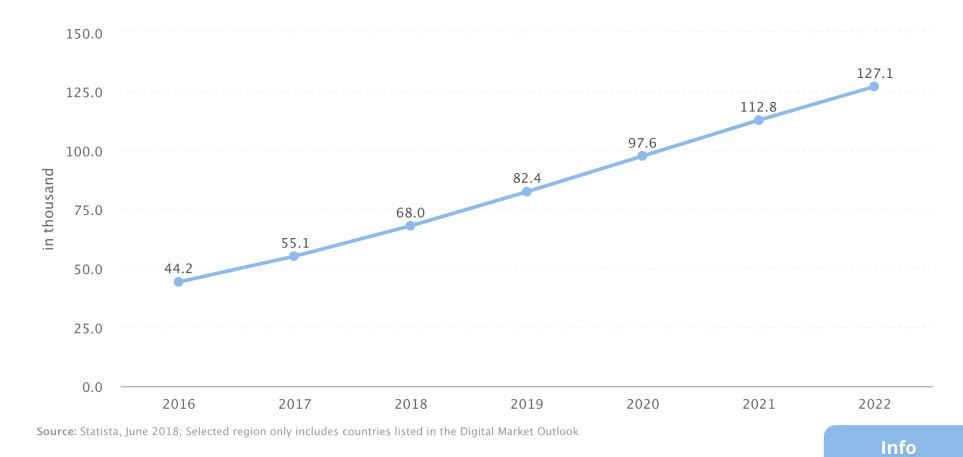
Q. What can equity crowdfunding be used for?
A: Any purpose you define to your investors. Startups have used equity crowdfunding to fuel marketing campaigns, add new locations, develop new products and services, make hires, purchase inventory, and more.
Hopefully, these FAQs cleared up any remaining questions you had about crowdfunding basics. Check out this case study to learn more:



The $1M Travel Bag: Inside Nomad Lane’s Indiegogo Win

How do you end up creating one of the hottest pieces of luggage in recent history? It helps to travel a lot.
Kishore Vasnani and his wife, Vanessa Jeswani, had lived a jet-setting lifestyle for years, traveling to visit her relatives in the Philippines, taking off to his jobs in Atlanta and New York City, plus hitting up vacation destinations galore. In 2017, the pair decided to pool their talents to create a travel-themed company that supported their own nomadic lifestyle.
At first, Nomad Lane stocked existing travel products such as baggage tags and passport holders, but soon the couple started thinking about creating unique products of their own. Oneplus: Jeswani’s family had manufacturing experience.
Their first product, the Bento Bag, turned out to be a smash hit on Indiegogo, raising just over $1 million in August 2018. It was the couple’s first crowdfunding campaign, and they’d initially set their goal at just $15,000.
How did they choose Indiegogo? It turns out, Indiegogo chose them. The crowdfunding platform poached them after execs saw a media mention of the Bento Bag in Fast Company (that Jeswani cannily scored a few months before the crowdfunding campaign). It reported that the couple planned to use rival Kickstarter.
There are a million travel bags on the market already. How did the Bento Bag, with its many compartments and handy phone-charger pockets, stand out? The battle plan began roughly five months before the crowdfunding campaign, with hard scrutiny of costs and manufacturing needs to make sure the pair could deliver the Bento Bag as promised and make a profit at retail after the campaign.

Kishore Vasnani, Nomad Lane
“We didn’t say this is the best bag, or the ultimate bag,” Vasnani says. “We said, ‘We have put a lot of thought into the design of this bag.’ We had a pre-launch landing page saying, ‘A thoughtful bag is coming soon,’ ” with a photo of it under an airplane seat.
“Then we ran some Facebook ads for $5–$10 a day, saying, ‘We’re launching soon, put in an email to get a discount.’ ”
These moves built a 5,000-person list Nomad Lane could tap when their campaign went live. A special pre-launch page link went out only to the list that showed a sneak peek at the product features. This drummed up support for the Indiegogo campaign the day it went live.
This allowed Nomad Lane to meet its fundraising goal on day one—a move that generates heavy buzz for a campaign and helped the startup get featured on Indiegogo’s home page.
How did they keep momentum rolling from there?
“We started listening to people,” Vasnani says. “My advice? If you’re awake and someone messages you during a campaign, just immediately reply. If you look at our comments section, I have meticulously replied to every single comment. As a startup competing with major, $50 million brands, we need every advantage we can get.”
With $800,000 raised midway through, Jeswani’s media savvy brought another big score: a Forbes profile on the bag’s crowdfunding success. That exposure helped put the Bento Bag over the $1 million mark, Vasnani says.
In the end, Nomad Lane put 7,000 bags into customers’ hands, giving the brand exposure and a chance to build buzz. Next, they’re hoping to make more sales at retail prices and begin profiting from their exposure on Indiegogo.
